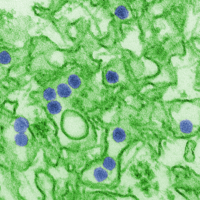
Photo from wikipedia
The 2015–2017 Zika virus (ZIKV) outbreak in Brazil and subsequent international epidemic revealed the strong association between ZIKV infection and congenital malformations, mostly neurodevelopmental defects up to microcephaly. The scale… Click to show full abstract
The 2015–2017 Zika virus (ZIKV) outbreak in Brazil and subsequent international epidemic revealed the strong association between ZIKV infection and congenital malformations, mostly neurodevelopmental defects up to microcephaly. The scale and global expansion of the epidemic, the new ZIKV outbreaks (Kerala state, India, 2021), and the potential burden of future ones pose a serious ongoing risk. ABSTRACT Vertical transmission of Zika virus (ZIKV) leads with high frequency to congenital ZIKV syndrome (CZS), whose worst outcome is microcephaly. However, the mechanisms of congenital ZIKV neurodevelopmental pathologies, including direct cytotoxicity to neural progenitor cells (NPC), placental insufficiency, and immune responses, remain incompletely understood. At the cellular level, microcephaly typically results from death or insufficient proliferation of NPC or cortical neurons. NPC replicate fast, requiring efficient DNA damage responses to ensure genome stability. Like congenital ZIKV infection, mutations in the polynucleotide 5′-kinase 3′-phosphatase (PNKP) gene, which encodes a critical DNA damage repair enzyme, result in recessive syndromes often characterized by congenital microcephaly with seizures (MCSZ). We thus tested whether there were any links between ZIKV and PNKP. Here, we show that two PNKP phosphatase inhibitors or PNKP knockout inhibited ZIKV replication. PNKP relocalized from the nucleus to the cytoplasm in infected cells, colocalizing with the marker of ZIKV replication factories (RF) NS1 and resulting in functional nuclear PNKP depletion. Although infected NPC accumulated DNA damage, they failed to activate the DNA damage checkpoint kinases Chk1 and Chk2. ZIKV also induced activation of cytoplasmic CycA/CDK1 complexes, which trigger unscheduled mitotic entry. Inhibition of CDK1 activity inhibited ZIKV replication and the formation of RF, supporting a role of cytoplasmic CycA/CDK1 in RF morphogenesis. In brief, ZIKV infection induces mitotic catastrophe resulting from unscheduled mitotic entry in the presence of DNA damage. PNKP and CycA/CDK1 are thus host factors participating in ZIKV replication in NPC, and pathogenesis to neural progenitor cells. IMPORTANCE The 2015–2017 Zika virus (ZIKV) outbreak in Brazil and subsequent international epidemic revealed the strong association between ZIKV infection and congenital malformations, mostly neurodevelopmental defects up to microcephaly. The scale and global expansion of the epidemic, the new ZIKV outbreaks (Kerala state, India, 2021), and the potential burden of future ones pose a serious ongoing risk. However, the cellular and molecular mechanisms resulting in microcephaly remain incompletely understood. Here, we show that ZIKV infection of neuronal progenitor cells results in cytoplasmic sequestration of an essential DNA repair protein itself associated with microcephaly, with the consequent accumulation of DNA damage, together with an unscheduled activation of cytoplasmic CDK1/Cyclin A complexes in the presence of DNA damage. These alterations result in mitotic catastrophe of neuronal progenitors, which would lead to a depletion of cortical neurons during development.
Journal Title: Journal of Virology
Year Published: 2022
Link to full text (if available)
Share on Social Media: Sign Up to like & get
recommendations!